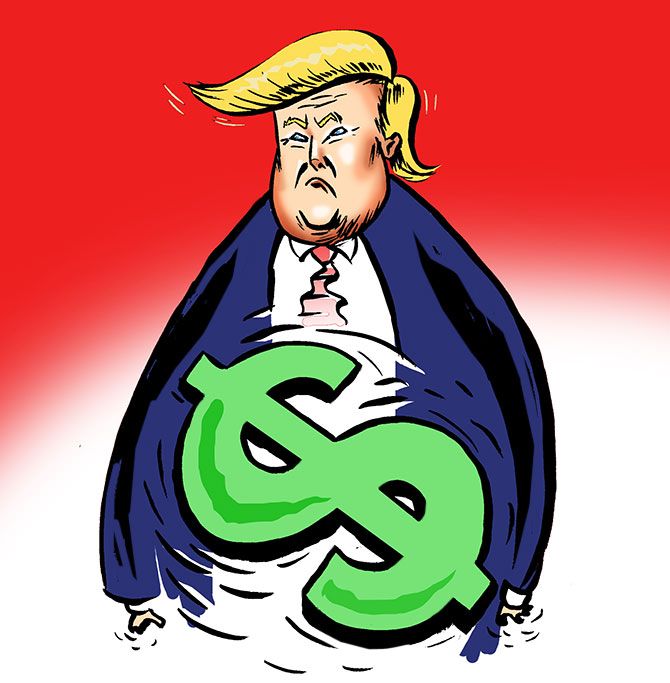'Indian voters clearly get it. It’s all about the economy and India becoming more competitive and attracting more (foreign investments).'
'The assembly election results also affirm our existing investment convictions in financials, sectors with a large informal business presence, and infrastructure.'
Illustration: Dominic Xavier/Rediff.com.

For investors in Asian equities, the current environment looks highly supportive, given the prospect of double-digit earnings growth, says Geoff Lewis, senior strategist for Asia, Manulife Asset Management, which has $343 billion in assets under management globally.
Lewis tells Puneet Wadhwa that if he had to choose between the developed and emerging markets, in 2017, he would be biased towards the latter.
How do you interpret Donald Trump’s presidency and its implications for global economies and markets?
My suspicion is that Trump will actually be quite positive for global growth and, thus, for Asia from the second half of calendar year 2017 onwards, along possibly with the less welcome side-effects of higher US inflation and a stronger dollar.
Indeed, the main risk for the emerging markets, including those of Asia, in coming months is likely to be the return of a stronger US dollar.
We acknowledge there is considerable political uncertainty in the near term, both in the US and abroad, especially in the UK and Europe. But, in the absence of major political gaffes by Trump that hurt investor sentiment, the door is surely open for rising US economic activity in the year ahead, given a looser fiscal stance.
The US and the Indian equity markets have seen a good run. Is there steam left in the rally in both markets?
Both markets, we expect, will end the year higher than they stand today, but the Indian stock market probably has more potential headroom than the S&P500.
Economic data is good in both cases, though in India, structural reforms are now expected to proceed or even accelerate after Modi’s convincing victory in the Uttar Pradesh elections.
Indian voters clearly get it.
It’s all about the economy and India becoming more competitive and attracting more (foreign investments).
What about market valuations?
Valuations today are certainly not cheap, but nor are valuations alone a good predictor of short-term market direction. For example, equity corrections or bear markets in the US have occurred at valuations below the long-run average.
For now, while the positive surprises and good macro data continue, the global reflation rally should be well supported.
Will the developed markets score over the emerging markets in terms of allocation by foreign investors in CY17?
We think that the real call might be more between ‘should I continue to stay overweight US equities’ or ‘will 2017 be a year in which non-US stock markets outperform’.
But, as to a choice between the DM and EM, in 2017, we would be biased in our asset allocation towards the latter. For investors in Asian equities, the current environment looks highly supportive based on two key observations: the prospect of double-digit EPS growth following the bottoming in return on equity last autumn, and the best start to the reporting season since 2010. All things considered, we are inclined to go with the improving economic data and stay fully invested.
We will put 2017’s considerable global geopolitical uncertainties to one side for now.
How do you interpret the outcome of the assembly polls in India?
Although the BJP was expected to do well in the assembly elections, the scale of victory exceeded expectations.
Indeed, the BJP’s performance will cement Prime Minister Modi’s authority in the party and government. It will also be positive for the implementation of the central government’s agenda of anti-corruption policies, indirect tax reform, and state spending on infrastructure, housing, rural development.
The results also affirm our existing investment convictions in financials, sectors with a large informal business presence, and infrastructure. We look to see the energetic implementation of GST (goods and services tax), a more rapid divestment of public sector enterprise assets and more rapid realisation of non-performing loans in India’s banks.
Which sectors are you overweight and underweight on in the Indian context?
In our India portfolio, we remain constructive and overweight on our favourite investment themes.
First, we see increased household savings being put in financial institutions due to positive real interest rates and government efforts to formalise the economy (increasing banking through digital, demonetisation, indirect tax reform). Sectors that will benefit from these trends include mid-sized banks, insurance companies, and wealth and asset managers.
Second, we see the formalised sectors of the economy gaining market share from the informal sectors. Sectors that will benefit from this trend include: food, jewellery, apparel, light electricals where the informal sector used to play an outsized role.
Third, continued government focus on infrastructure investment. The cement sector will be the main beneficiary of this trend. We are currently underweight on sectors linked to rural demand, but we will continue to assess this position if there are new policy developments.











